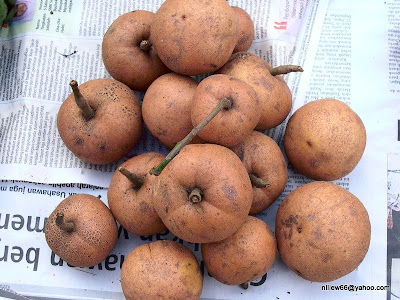Some lucky mornings at the farmers' market, one may chance upon uncommon produce when Mother Nature is abundant in her offings...
These are retro-pics as they were taken back in 2005 but still look fresh and interesting. As Raub has many villages set on the fringes of the valley between the Main Range and the Benom Range, natural produce from the jungle are essentially exploited for human consumption. Here are some very natural ones and some very traditional ones as well finding their ways into the kitchen of Raubians...
These are retro-pics as they were taken back in 2005 but still look fresh and interesting. As Raub has many villages set on the fringes of the valley between the Main Range and the Benom Range, natural produce from the jungle are essentially exploited for human consumption. Here are some very natural ones and some very traditional ones as well finding their ways into the kitchen of Raubians...
 Fruit from the jungle, the Tampoi, a fruit with duku-like flesh but trapped in extremely thick white pith of its shell. Sourish to sweet.
Fruit from the jungle, the Tampoi, a fruit with duku-like flesh but trapped in extremely thick white pith of its shell. Sourish to sweet. Traditional villages normally has one or two of it around the corners of the village. This is Pauh, a non-hybrid mango that can sometimes be found at the fringes of the forest.
Traditional villages normally has one or two of it around the corners of the village. This is Pauh, a non-hybrid mango that can sometimes be found at the fringes of the forest. An almost extra-terrestrial-like cousin of the Kerdas, with its strange form and pinkish flesh -the Keladan, a seasonal nut from the jungles of Malaysia. As it is collected from the forest floor, it is collected at a stage where the nuts begin to germinate, hence their unusual appearance.
An almost extra-terrestrial-like cousin of the Kerdas, with its strange form and pinkish flesh -the Keladan, a seasonal nut from the jungles of Malaysia. As it is collected from the forest floor, it is collected at a stage where the nuts begin to germinate, hence their unusual appearance. Daun Seripok, a jungle creeper that is cooked lightly in coconut milk and tumeric in a style widely practiced in the kitchens of traditional Pahang - masak lemak. For the initiated only.
Daun Seripok, a jungle creeper that is cooked lightly in coconut milk and tumeric in a style widely practiced in the kitchens of traditional Pahang - masak lemak. For the initiated only. Belimbing Asam, a very sour starfruit that is traditionally used in this region to replace the Asam Gelugur in sambals and curries.
Belimbing Asam, a very sour starfruit that is traditionally used in this region to replace the Asam Gelugur in sambals and curries.





No comments:
Post a Comment